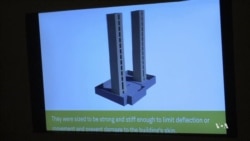Natural disasters -- tornados, hurricanes, floods, earthquakes and forest fires -- occur frequently, and often unexpectedly, across the United States, but there is technology that can help save property and lives.
An exhibition at Washington’s National Building Museum showcases some of these technologies.
For example, large buildings and other structures can withstand even strong earthquakes if they are built with some degree of flexibility.
“We need to let buildings move and we can actually understand where they might fail and then go in and design buildings with that in mind,” said exhibition curator Chrysanthe Broikos.
The so-called ‘special moment frame,’ allows a degree of movement at points where large load-bearing beams join each other.
Rubber-based foundation blocks let buildings sway, while huge shock absorbers dampen vibrations.
A model of the wind wall, built at the International Hurricane Research Center, in Florida, shows how certain types of roofs are more vulnerable than others to the strong winds of tornados and hurricanes.
For example, a hipped roof shape withstands better than the flat roof or the gable roof, according to Broikos.
In areas affected by strong winds, scientists also recommend having at least one ‘safe room’ where inhabitants can spend the most dangerous part of the storm.
To keep storm surges in check, some communities along the U.S. coasts and river banks built artificial reefs, using not just rocks but also oyster shells, collected from restaurants.
”It turns out that oyster reefs actually help to attenuate wave action," said Broikos. "They also help with soil erosion.”
Broikos also says building parks along the shoreline, instead of houses, is more natural and keeps valuable property away from danger.
As for forest fires, scientists now recommend that a so-called home ignition zone be about 60 meters wide.
”What that means is trying to keep that area free of material that easily combusts,” Broikos said.
Some natural disasters cannot be prevented but researchers say advance planning and timely investment can provide the same sort of protection as applying sunblock lotion before going to the beach.
An exhibition at Washington’s National Building Museum showcases some of these technologies.
For example, large buildings and other structures can withstand even strong earthquakes if they are built with some degree of flexibility.
“We need to let buildings move and we can actually understand where they might fail and then go in and design buildings with that in mind,” said exhibition curator Chrysanthe Broikos.
The so-called ‘special moment frame,’ allows a degree of movement at points where large load-bearing beams join each other.
Rubber-based foundation blocks let buildings sway, while huge shock absorbers dampen vibrations.
A model of the wind wall, built at the International Hurricane Research Center, in Florida, shows how certain types of roofs are more vulnerable than others to the strong winds of tornados and hurricanes.
For example, a hipped roof shape withstands better than the flat roof or the gable roof, according to Broikos.
In areas affected by strong winds, scientists also recommend having at least one ‘safe room’ where inhabitants can spend the most dangerous part of the storm.
To keep storm surges in check, some communities along the U.S. coasts and river banks built artificial reefs, using not just rocks but also oyster shells, collected from restaurants.
”It turns out that oyster reefs actually help to attenuate wave action," said Broikos. "They also help with soil erosion.”
Broikos also says building parks along the shoreline, instead of houses, is more natural and keeps valuable property away from danger.
As for forest fires, scientists now recommend that a so-called home ignition zone be about 60 meters wide.
”What that means is trying to keep that area free of material that easily combusts,” Broikos said.
Some natural disasters cannot be prevented but researchers say advance planning and timely investment can provide the same sort of protection as applying sunblock lotion before going to the beach.








